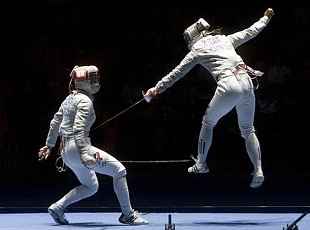RULES OF FENCING: We focus on fencing rules and regulations for the most common branch. That happens to be Olympic fencing.
There are two other versions of fencing swords. One is the classical version based around martial arts. The other is the lesser known historical fencing sport.
The defensive sport governed by fencing rules in the United Kingdom is still considered by many to be an elitist activity.
This could be due to fencing’s long and established history. It has a historical association with aristocratic types of fencing swords dueling.
Modern competitive combat fencing is one of only a handful of sports which have featured in all Olympic Games. Competitive fencers duel with one of three rapier-like sword weapons called foil, sabre, or épée.
Fencing Rules and Regulations
Fencing rules and regulation are currently governed and regulated by Fédération Internationale d’Escrime. The FIE governs from Switzerland according to the chosen scene.
The basic aim in the game is to strike your opposing fencer with your weapon. Avoiding a hit yourself, is another part of the regulatory fundamentals. It is quite painful when fencers make errors or misjudgments.
There are fencing team events with multiple fencers. But as a rule only one fencer contests against another single individual. Each contestant wears protective equipment. They will both use one of three different types of fencing swords.
Types of Fencing Swords
- Foil: The rules of fencing foil use a light weapon. Fencers use it for thrusting into their opponent.
- Sabre: The saber is a thrusting and cutting fencing sword (like a cavalry weapon).
- Epée: Fencing epée rules use the heaviest of the three weapons.
Serious injuries in fencing sport rules are actually quite rare. That is down to the protective attire and armour that fencers wear.

A fencing mask is also made of tough mesh material. The mesh repels the pointed edge of a fencing sword, but still allows a fencer to see through it.
The strong helmet completely covers the rest of the head for protection. A fencing jacket protects a competitor’s body. They also wear a variety of thick pads and a fencing glove on the hand used to hold the weapon.
Scoring Rules of Fencing Game
The competition gets played on a piste measuring 14 meters long and about two meters wide. The centre line divides two on-guard lines which run across the width of the piste. They get marked off six feet either side.
This position is where fencers start their sword fight challenge at the start of each round.
Failure to salute your fellow fencer, and the referee, at the beginning of the bout is a fencing rules infringement. This may cost you the loss of a point or potential suspension from the game altogether. The salute should also occur again after the completion of the duel.
- Scores are usually regulated and registered electronically in a scoring box.
- Successful strikes activate an audible tone and an illuminating light.
- Fencing sword types are electronically sensitive.
- A chord connects body scoring areas to the scoring box.
- You cannot barge into your challenger. Likewise blocking shots with your hand are against Olympic fencing rules and regulations.
- Scoring with the foil tip only counts when it strikes the back, torso, groin, or neck.
- Striking outside these areas with a foil weapon pauses the contest.
- Sabre strikes do not count beneath the waist. In fact, this rule originates from the cavalry days. That is when they considered striking a horse to be ‘ungentlemanly‘ conduct.
- Fencers may score with the tip or blade of the sabre.
- The referee applies the ‘right of way rule‘. It happens if players strike each other at the same time (the points get awarded to first attacker).
- The right of way rule does not apply with the epée.
- Both, fencers may score ‘simultaneously‘ when striking with the epée. Note: The rules for fencing do not allow this if it is the deciding point.
- The whole body is a target in epée. But, you may only score with the tip of these types of fencing swords.
Olympic Games Fencing Regulations
Matches in the Olympic Games take place over three separate rounds and each for 3 minutes. The winner is the first player to score 15 points or the player with most hits at the end of the rounds.
There are other Olympic scoring protocols. They include the predetermined point system of scoring 5 points over a 3 minute round.
This introduction of how to fence with a sword should benefit beginners most. It is also useful for anyone who is new to the sport and spectators of the game. This insight should show that the rules of fencing are not as hard to learn as you may have first thought.
Note: We will continue this guide with more fencing regulations under the official rule book of fencing.
Advanced Fencing Sport Rules
ALSO IN THIS SECTION
A-Z List of Sports Rules: A collection of popular indoor and outdoor sport categories.
Judo Rules and Regulations: Learn how to follow the Olympic rules of judo contests.
Strange Sports Rules: A huge list of weird and wonderful worldwide sporting events.
FIE Fencing Rules Book: [PDF Download Option]

